Maserati GranTurismo 2023 review: Power and beauty mix with comfort and even electric power in the new Italian GT
Comeback king
By the end of its life, the old Maserati GranTurismo had become a bit of a dinosaur. Although it remained beautiful and characterful, it was a bit of a blunt instrument – a V8-powered sledgehammer, if you will. But now, after a short hiatus, the GranTurismo badge is back, and it adorns a thoroughly modern sports coupé.
Although the new car shares a name with its predecessor, that’s pretty much all the two cars have in common. As well as completely new underpinnings hidden by fresh styling and a new interior, the newcomer is the first GranTurismo to offer customers the choice between petrol and pure-electric power.
But will all this modernity rob the GranTurismo of its soul, or will it make the new car even more appealing than its forebears, and finally a match for its competitors?
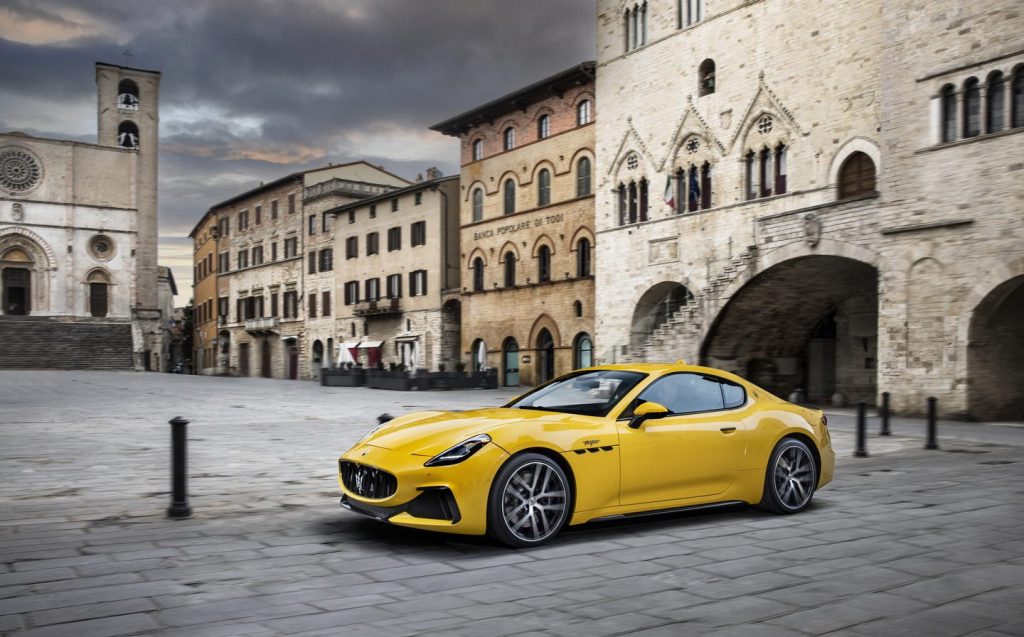
Exterior design and rivals
Despite the thorough ground-up refresh, there’s no mistaking this for anything other than the new GranTurismo, so similar is the design to that of the previous model. Both cars share a low snout and prominent haunches, as well as more subtle details such as the trademark Maserati gills on the front wings. But if you compare old and new, you might spot the slightly cleaner lines and the marginally less muscular shape.
Maserati has made a concerted effort to improve the car’s aerodynamic properties, fitting a grille that opens and closes depending on the cooling demands, and changing the bumpers between petrol-powered Modena and Trofeo models and the electric Folgore.
And of course, the Folgore does without the exhaust exits that are cut into the rear bumper on petrol-powered versions.
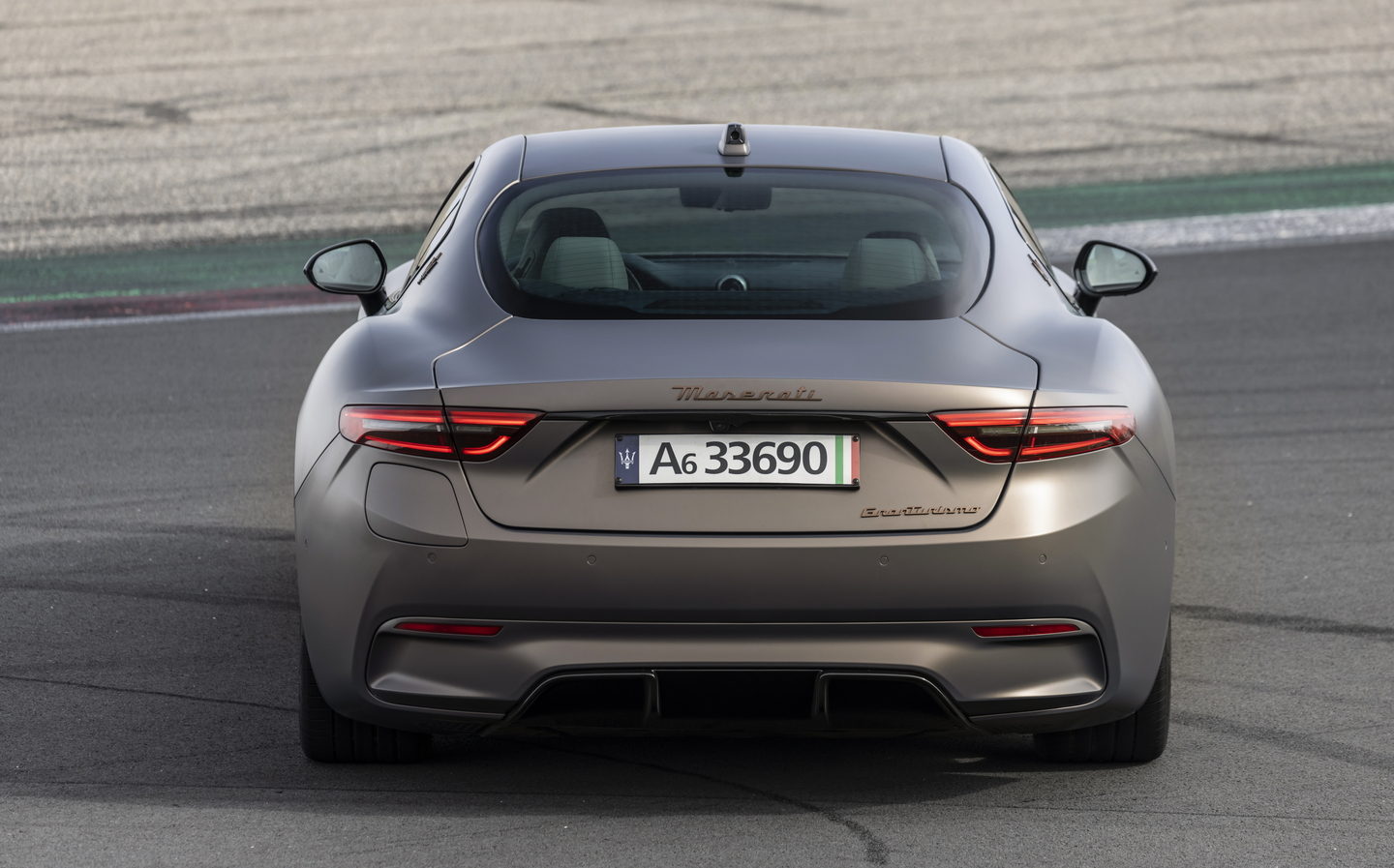
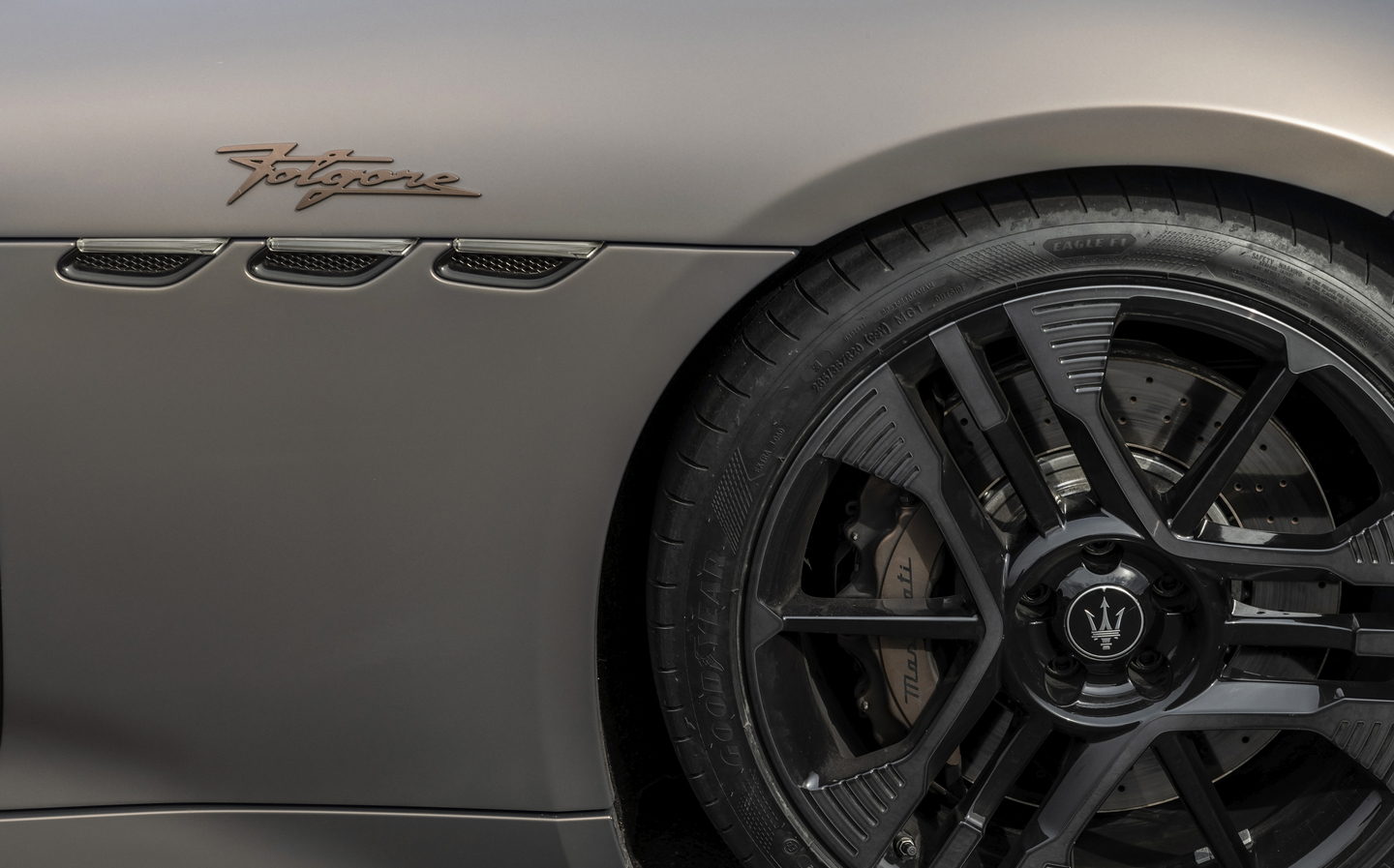
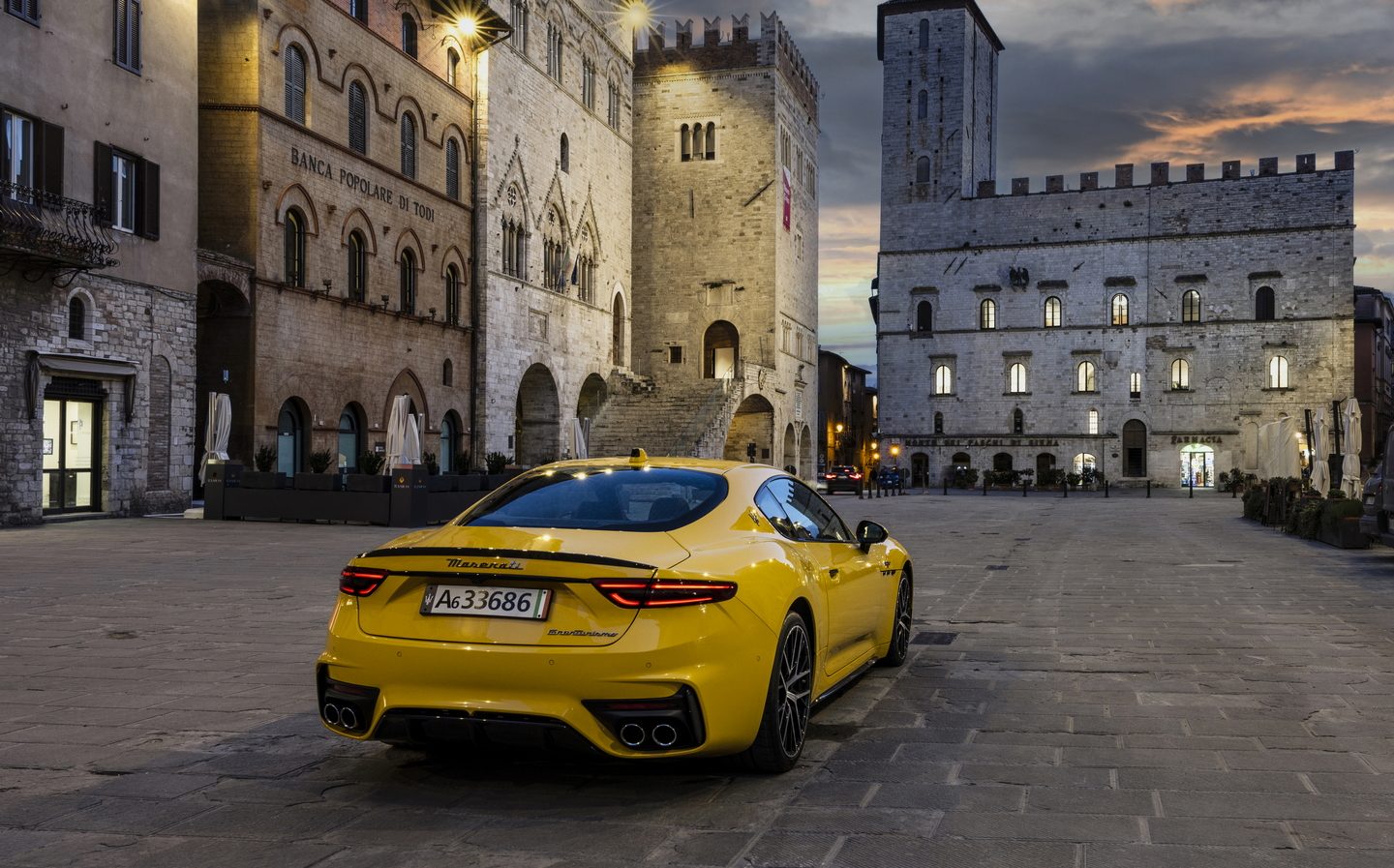
Whether you choose the Folgore or one of the V6 GranTurismos, though, you’re getting one of the best-looking grand tourers on the market. From every angle, the GranTurismo is absolutely beautiful, and it looks at home alongside rivals such as the Aston Martin DB11 and the Bentley Continental GT.
At least it does if you leave the options list alone. Maserati is keen to shout about its personalisation options that allow you to festoon your GranTurismo with colourful trim and big decals, but this is a car that looks best in more restrained guises.
Pick one of the good colours – the lustrous red or the deep, complex blue – and stick with the standard chrome trim. The classy look suits the GranTurismo.
Interior and practicality
Maserati is well aware it has a fine line to tread when it comes to interiors. With increasing focus on technology, it has to keep up with the competition on that front while still nodding to its reputation for more traditional craftsmanship and style.
Fortunately, as with the MC20 supercar, Maserati has done a solid job of mixing classic style with modern must-haves.
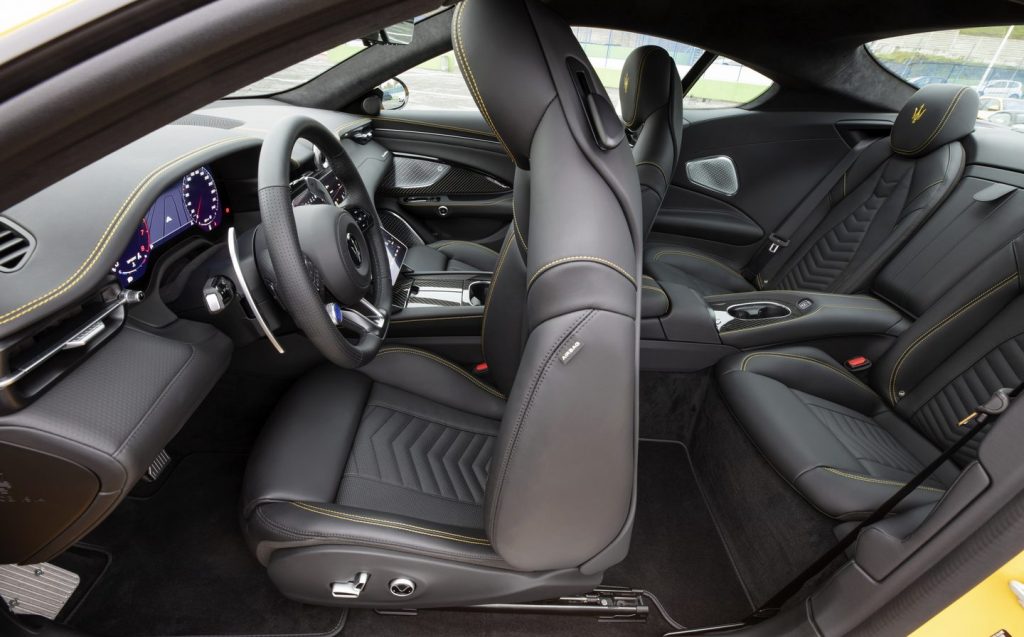
It is a much more tech-heavy cabin than before – the analogue instruments have been replaced with a digital screen and there’s a new touchscreen system – but some of the trademarks remain. Sculpted surfaces are wrapped in premium materials and the classic Maserati clock remains, albeit with a modern twist (more on that later).
Go for the Modena variant and you still get wood trim and sumptuous leather, but the Trofeo gets sportier carbon-fibre decorations. And the electric version we tested used high-tech laser-cut upholstery made from recycled fishing nets.
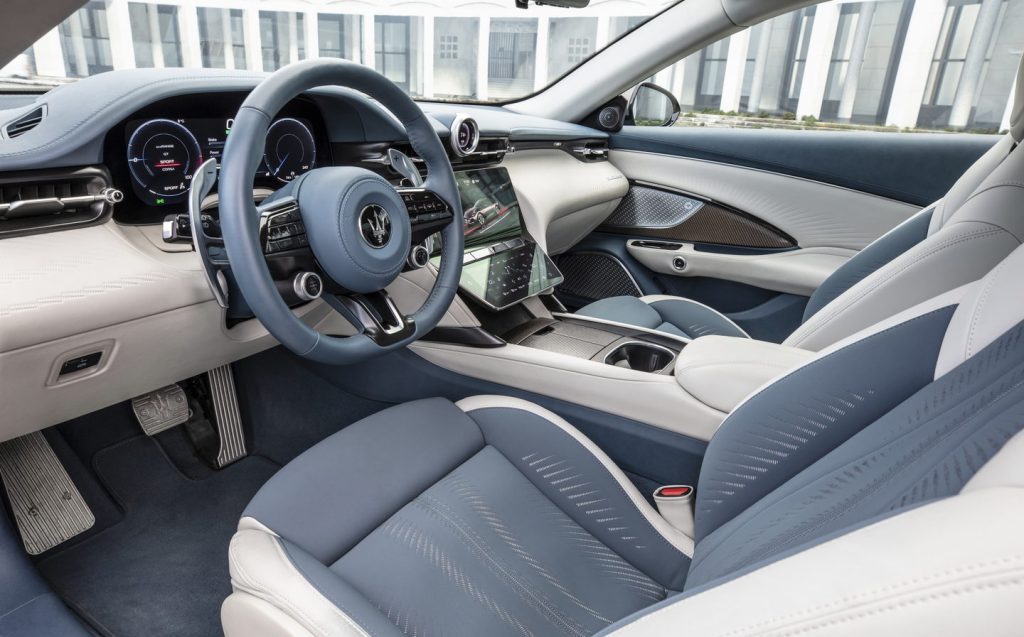
Whichever version you choose, though, the GranTurismo feels like a quality item. Everything from the operation of the door handles to the action of the cupholder cover feels premium and robust.
We have just a handful of quibbles, including with the slightly plasticky trim around the clock and the cheap-feeling buttons on the steering wheel, but that’s nit-picking. Overall, the GranTurismo’s cabin feels great.
Space has also improved noticeably, with a little more room in the back for passengers. It isn’t a true four-seater but you can squeeze adults in there, as long as those in the front aren’t exceptionally tall. Comfort is limited, and nobody will want to spend too long in the back, but it’s fine for short trips and it’s much better in this regard than some of its rivals.
Boot space is similarly competitive, with the petrol-powered GranTurismos offering 310 litres of luggage capacity. That isn’t huge, but it’s more than you get from a Ford Fiesta — although the boot shape is predictably less practical.
The electric GranTurismo, however, hides its rear motors under the boot floor, so you get just 270 litres of luggage space – roughly what you got from the old, V8-engined GranTurismo and should be sufficient for a week away, especially if you can use the back seats as a glorified parcel shelf.
Technology and safety
In essence, the GranTurismo’s on-board technology is pretty much identical to that of the Maserati Grecale SUV. You get the same digital instrument display and the same two central touchscreens, which is something of a mixed blessing.
While the screens are undoubtedly much better than those fitted to the old GranTurismo, they still have the occasional complicated menu and suffer from some lag. They don’t look as good as the screens fitted to Bentleys and BMWs, either.
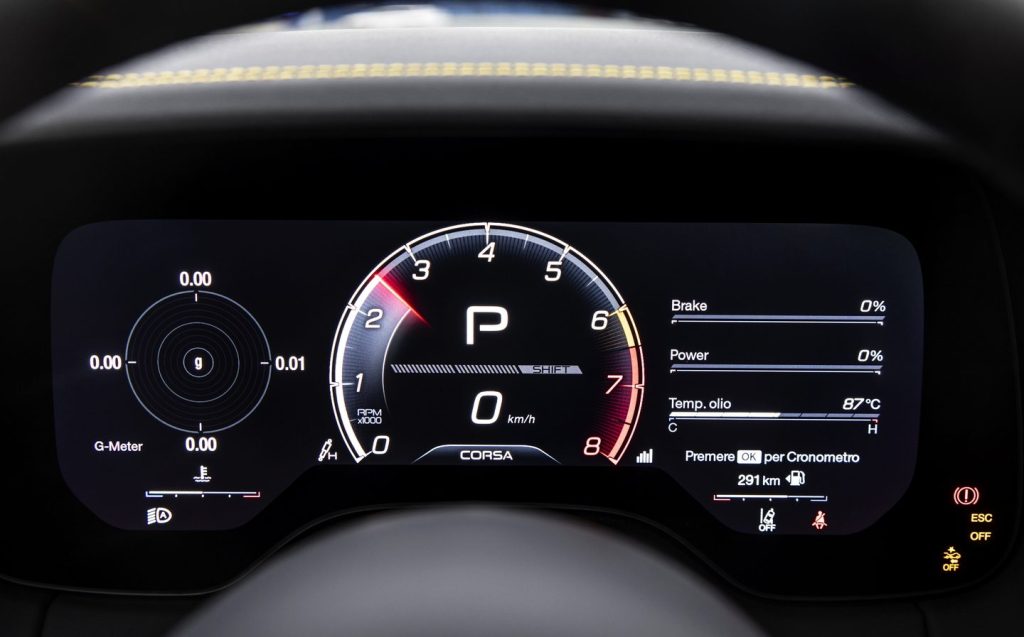
Then there’s the question of ergonomics. As with the Grecale, the GranTurismo’s lower screen is awash with vehicle functions as Maserati strives to clean up its dashboard. Everything from the climate control to the lift kit that raises the nose when you want to drive over a speed bump is on that screen, and it gets busy as a result. And if it stops working for any reason, you could be in a slightly uncomfortable place.
In fairness, it’s reminiscent of the system from Audi and usually works just as well, but we’d prefer some proper switchgear.
The GranTurismo’s digital instrument display is pretty good, though, mixing clean graphics with configurable sections that can show a wealth of information. It’s a shame it’s controlled by those cheap buttons on the steering wheel, but it does the job.
The head-up display is impressive but because of the car’s low seat position it can get in the way of the road ahead a little.
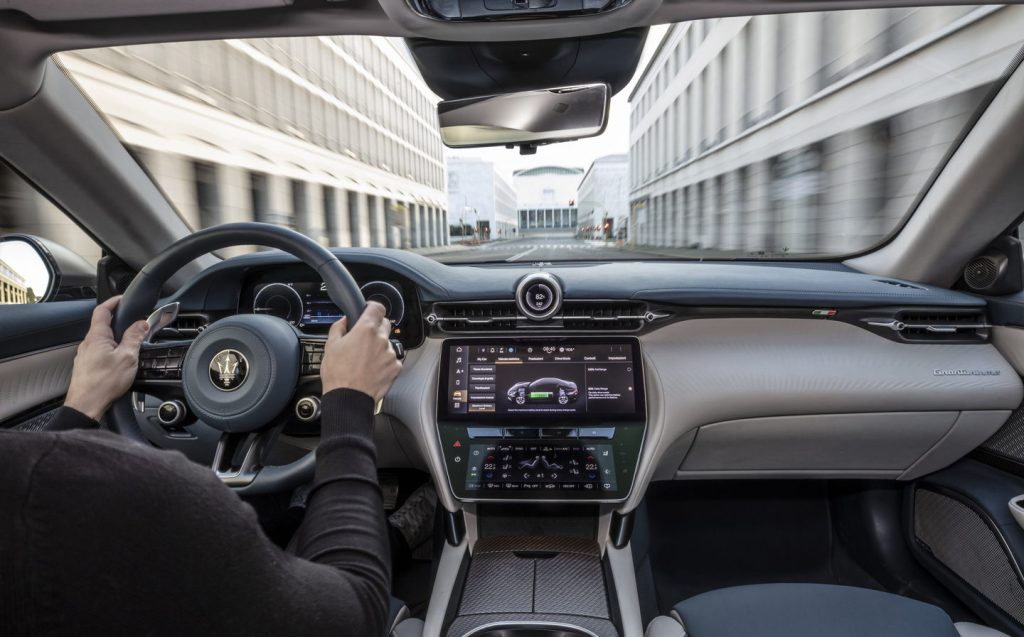
And then there’s the unassuming clock face in the middle of the dash. Traditionally, this would have been a lovely analogue thing with solid needles and a blue dial, but now it’s a digital display that can transform itself at the push of a button. Normally, it displays an interpretation of the classic clock, but it can also be a G-meter or a lap timer. In electric examples it’ll also tell you how your charging session is going.
Performance, power output and acceleration
Whereas the old GranTurismo was only available with a stonking great V8 under the bonnet, Maserati is offering the new GranTurismo with a choice of propulsion systems.
The entry-level option – if you can call it that – is the Modena, which uses a detuned version of the MC20 supercar’s 3-litre twin-turbocharged V6 petrol engine. But with 483bhp going to all four wheels via an eight-speed automatic gearbox, it isn’t what you’d call slow. The sprint from 0-62mph takes less than four seconds and the top speed is nudging 190mph.
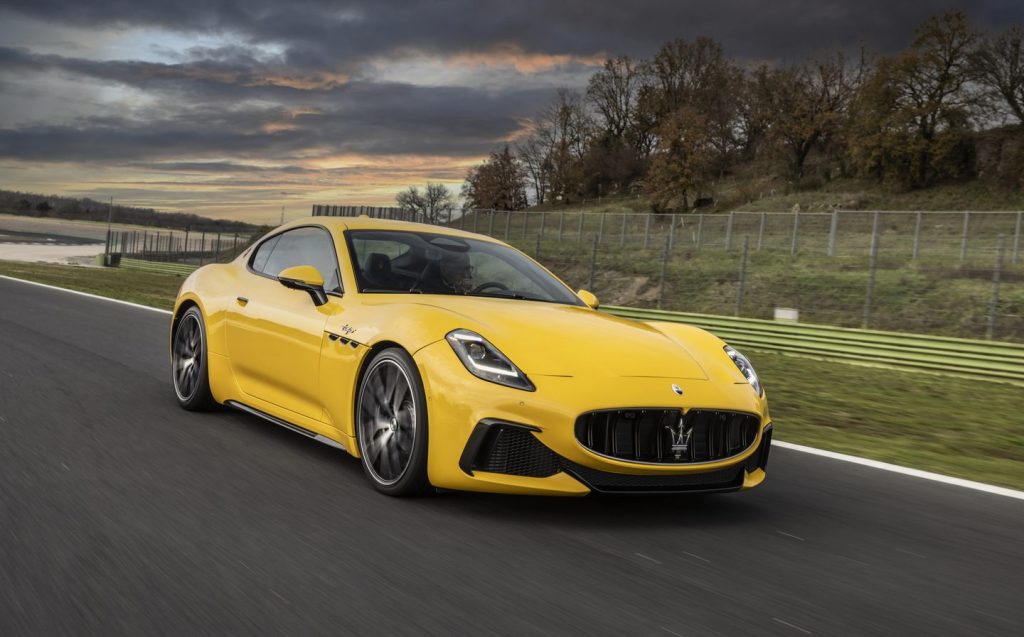
But the Modena is not quite as fast as the Trofeo, which uses the same engine, gearbox and all-wheel-drive system, but squeezes out a little more power. With 542bhp to play with, it shaves four tenths from the 0-62mph time and takes the top speed to just under 200mph.
Astonishingly, however, even the Trofeo is not the pinnacle of the GranTurismo range, because there is a third way.
The Folgore, which means “lightning” in Italian, is the pure-electric option that lives up to its name in quite some style. With three motors – one at the front and two at the back – this all-wheel-drive coupé churns out a whopping 750bhp and almost 1,000lb ft of torque. That means you get face-melting, tyre-shredding performance, with a 0-62mph time of 2.7 seconds.
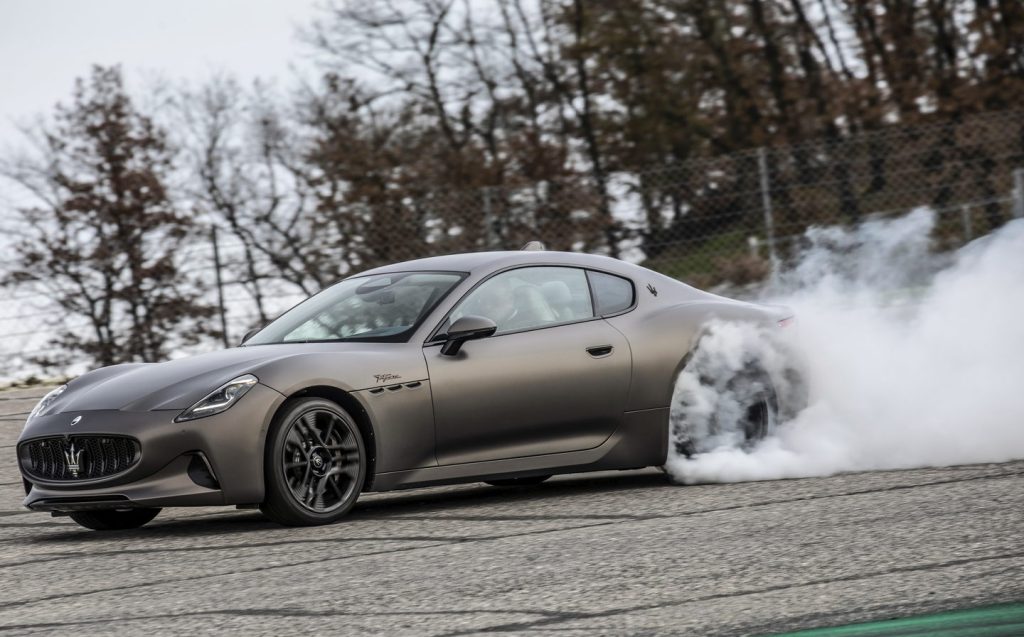
The scary thing is, this car could have been even faster. Because each motor is capable of producing up to around 400bhp at any one time, Maserati could have squeezed more than 1,200bhp from the Folgore. But the battery is the limiting factor. It simply can’t distribute that much power, so Maserati uses each motor’s spare capacity to shift the power around, with the computers deciding which of the three motors should do the lion’s share of the work.
But the battery is remarkable for more than just its limitations. It has a usable capacity of 83kWh which results in a single charge taking you around 280 miles officially, or about 220 in the real world (even Maserati admits this). However, the company also says it is constantly working to increase the available capacity, and an over-the-air update could see the official range get closer to 300 miles eventually.
For many customers, though, the overall range won’t matter that much. Because the Folgore comes with ultra-rapid 270kW charging, you can top up the battery from 20 to 80 per cent in just 18 minutes — assuming you can find a public charger fast enough for the job.
But the charging speed is hardly the most interesting facet of the GranTurismo experience. Maserati has worked hard on the sound of the cars, attempting to make up for the loss of that thumping V8. The V6 engines build on solid foundations, having already seen service (albeit in a more powerful state of tune) in the MC20 – a car that sounds like the heavens are falling in. In the GranTurismo, the ‘Nettuno’ V6 feels a little less raw, but no less menacing, and it’s a reasonable substitute for the characterful V8.
In the case of the Folgore, though, Maserati had its work cut out. The engineers decided to overlay the beat of the old V8 over a recording of an electric motor to create this weird hybrid soundtrack, then play it through the speakers. The resulting noise really is as odd as you imagine, and it won’t be everyone’s cup of tea.
Ride and handling
Despite its jaw-dropping performance, the GranTurismo feels exactly how a grand tourer should. It’s slightly softer than some of its rivals, even in its sportiest modes – Maserati can’t have the GranTurismo treading on the flagship MC20’s toes – but it’s sensational in its own way.
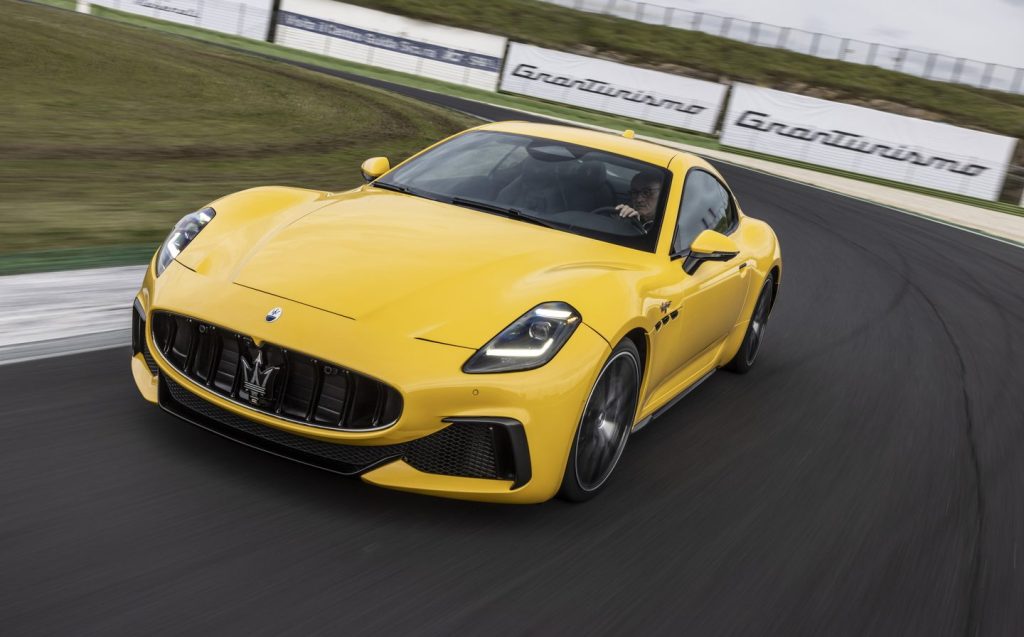
Although the Modena and Trofeo models are about 450kg lighter than the electric Folgore, the three cars feel remarkably similar. Because Maserati hasn’t laid the battery in a massive slab under the floor, the Folgore rolls through corners in much the same way as the petrol examples, with a little bit of smooth lean that somehow makes it more predictable and comfortable than some other electric sports cars.
That said, the different approach to weight distribution prevents the Folgore from feeling as aggressive as rivals such as the Porsche Taycan.
All of which means the GranTurismo is every inch the tourer, feeling at its best when driven at about eight tenths of its potential. There, it feels smooth and refined, flowing from corner to corner languidly despite its unquestionable pace.
And the car can still hold its own on a race track, aided by sharp steering that never feels too heavy and a clever four-wheel-drive system that doesn’t intrude too much.
It all feels as intuitive and as natural as a rear-driven car, but it has the traction of an all-wheel-drive one. So much so that Maserati admits the GranTurismo is faster than an MC20 on a lap of a frozen lake.
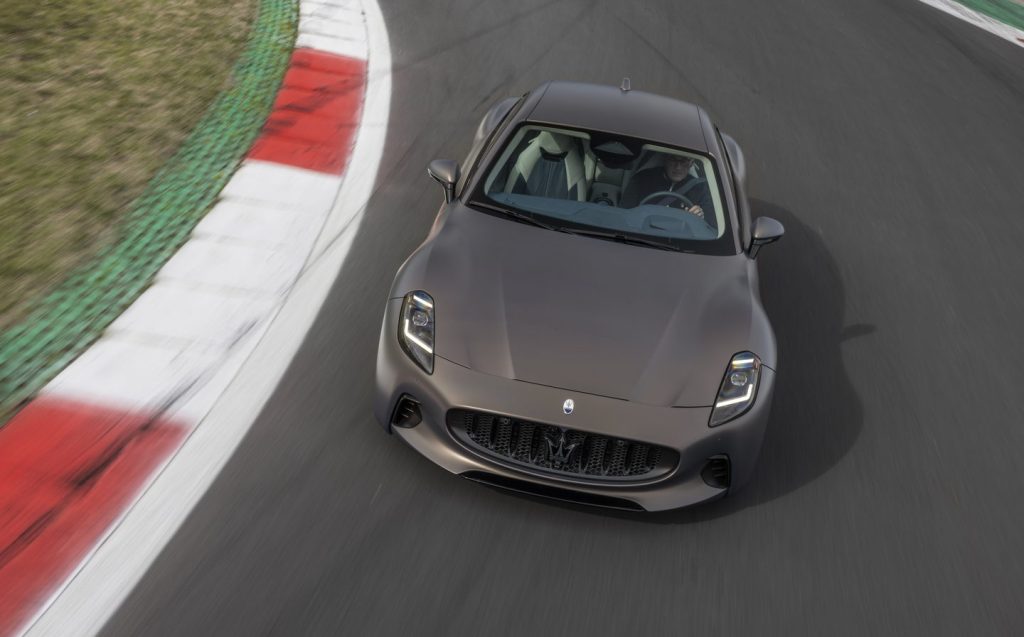
Odd accolades aside, the most impressive thing about the GranTurismo is the way it mixes this classic grand tourer handling with sound ride comfort.
Having only tested the Folgore on a track, we can’t comment on whether the extra weight will impact the ride, but the petrol-powered versions are supremely comfortable, even in their sportier settings. Cruise along a motorway in Comfort mode and the car simply wafts along, and while the low-speed ride on more uneven surfaces is naturally less cosseting, it’s still impressive for something so fast.
Mix this comfort with the well-judged handling and the effortlessness of the V6 engines or the refinement of the Folgore, and you’ve got a car that can easily mix it with the best grand tourers on the market.
Pricing and on-sale date
Maserati has not confirmed how much the new GranTurismo will cost, but the company has given us a pretty good idea. We’re expecting the basic Modena model to come in at around £140,000 or so, putting it roughly on a par with the BMW M8 Competition, while the Trofeo will cost another £20,000, putting that car in Aston Martin DB11 territory. The all-electric Folgore, meanwhile, will come with a price tag in the region of £185,000.
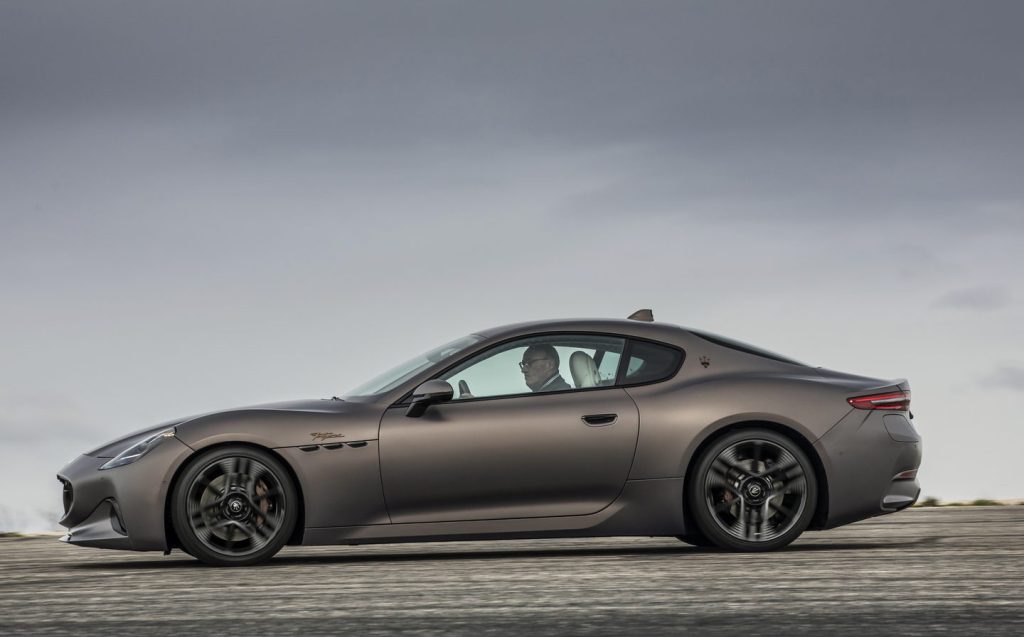
Although Maserati has not yet confirmed full specifications, we know every GranTurismo comes with air suspension as standard, as well as the three-screen dashboard arrangement. We also know the Modena will get the most traditional interior of the three cars, with wood and leather, while the Trofeo gets a sportier look thanks to some carbon-fibre trim.
Verdict: Maserati GranTurismo review
There’s no debating the GranTurismo’s capability. If money is taken out of the equation this is unquestionably one of the best two-door grand tourers money can buy.
Of course, there’s truth in the accusations that it’s a tad expensive, that the electric Folgore version doesn’t have the range of a Porsche Taycan, and those who want an out-and-out sports car might find it a little too soft for their liking.
But alongside a BMW 8 Series, an Aston Martin DB11 or a Lexus LC 500, the GranTurismo holds its own. And it just looks sensational. Were it not for the MC20, we’d be heralding this as the best Maserati in years.
Related articles
- After reading our Maserati GranTurismo review, you might like to check out what we had to say about the Porsche 718 Cayman GT4 RS
- Or read our review of the Maserati Grecale SUV
- Take a look at our review of the Ferrari 296 GTS as well to keep the Italian theme going
Latest articles
- Watch new Porsche 911 GT3 smash Nürburgring record for manual cars
- Skoda Elroq 2025 review: Czech carmaker can’t seem to miss with its electric family cars
- Five best electric cars to buy in 2025
- Should I buy a diesel car in 2025?
- F1 2025 calendar and race reports: The new Formula One season as it happens
- Zeekr 7X AWD 2025 review: A fast, spacious and high tech premium SUV — but someone call the chassis chief
- Denza Z9GT 2025 review: Flawed but sleek 1,062bhp shooting brake from BYD’s luxury arm
- Extended test: 2024 Renault Scenic E-Tech review
- Best-selling cars 2025: The UK’s ten most popular models of the year so far













